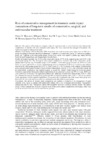Mostrar o rexistro simple do ítem
Role of conservative management in traumatic aortic injury: comparison of long-term results of conservative, surgical, and endovascular treatment
| dc.contributor.author | Mosquera Rodríguez, Víctor Xesús | |
| dc.contributor.author | Marini Díaz, Milagros | |
| dc.contributor.author | López-Pérez, José Manuel | |
| dc.contributor.author | Muñiz, Javier | |
| dc.contributor.author | Herrera, José M. | |
| dc.contributor.author | Cao, Ignacio | |
| dc.contributor.author | Cuenca, José J. | |
| dc.date.accessioned | 2015-09-01T08:02:50Z | |
| dc.date.available | 2015-09-01T08:02:50Z | |
| dc.date.issued | 2011-01-26 | |
| dc.identifier.citation | Mosquera VX, Marini M, López-Pérez JM, Muñiz-García J, Herrera JM, Cao I, Cuenca JJ. Role of conservative management in traumatic aortic injury: Comparison of long-term results of conservative, surgical, and endovascular treatment. J Thorac Cardiovasc Surg. 2011;142(3):614-621 | es_ES |
| dc.identifier.uri | http://hdl.handle.net/2183/14895 | |
| dc.description.abstract | [Abstract] Objective. The purpose of this study is to compare early and long-term results in terms of survival and cardiovascular complications of patients with acute traumatic aortic injury who were conservatively managed with patients who underwent surgical or endovascular repair. Methods. From January 1980 to December 2009, 66 patients with acute traumatic aortic injury were divided into 3 groups according to treatment intention at admission: 37 patients in a conservative group, 22 patients in a surgical group, and 7 patients in an endovascular group. Groups were similar with regard to gender, age, Injury Severity Score, Revised Trauma Score, and Trauma Injury Severity Score. Results. In-hospital mortality was 21.6% in the conservative group, 22.7% in the surgical group, and 14.3% in the endovascular group (P = .57). In-hospital aortic-related complications occurred only in the conservative group. Median follow-up time was 75 months (range, 5–327 months). Conservative group survival was 75.6% at 1 year, 72.3% at 5 years, and 66.7% at 10 years. Surgical group survival remained at 77.2% at 1, 5, and 10 years, whereas survival in the endovascular group was 85.7% at 1 and 5 years (P = .18). No patient in the surgical or endovascular group required reintervention because of aortic-related complications, whereas 37.9% of the conservative group had an aortic-related complication that required surgery or caused the patient’s death during the follow-up period. Cumulative survival free from aortic-related complications in the conservative group was 93% at 1 year, 88.5% at 5 years, and 51.2% at 10 years. Cox regression confirmed the initial type of aortic lesion (hazard ratio, 2.94; P = .002) and a Trauma Score-Injury Severity Score greater than 50% on admission (hazard ratio, 1.49; P = .042) as risk factors for the appearance of aortic-related complications. Two peaks in the complication rate of the conservative group were detected in the first week and between the first and third months after blunt thoracic trauma. Conclusions. The advent of thoracic aortic endografting has enabled a revolution in the management of acute traumatic aortic injury in patients with multisystem trauma with a low in-hospital morbimortality. Nonoperative management may be only a therapeutic option with acceptable survival in carefully selected patients. The natural history of these patients has revealed a marked trend of late aortic-related complications developing, which may justify an endovascular repair even in some low-risk patients. | es_ES |
| dc.language.iso | eng | es_ES |
| dc.publisher | Elsevier | es_ES |
| dc.relation.uri | http://dx.doi.org/10.1016/j.jtcvs.2010.10.044 | es_ES |
| dc.rights | Creative Commons Licence | es_ES |
| dc.rights | Reconocimiento-NoComercial-SinObraDerivada 4.0 Internacional | |
| dc.rights.uri | http://creativecommons.org/licenses/by-nc-nd/4.0/ | |
| dc.title | Role of conservative management in traumatic aortic injury: comparison of long-term results of conservative, surgical, and endovascular treatment | es_ES |
| dc.type | info:eu-repo/semantics/article | es_ES |
| dc.rights.access | info:eu-repo/semantics/openAccess | es_ES |
Ficheiros no ítem
Este ítem aparece na(s) seguinte(s) colección(s)
-
GI- GRINCAR - Artigos [216]






